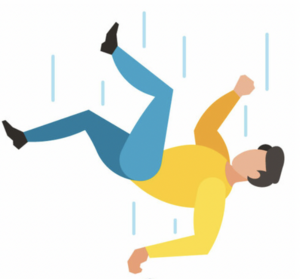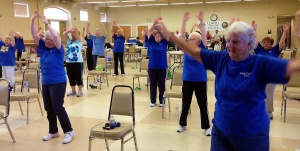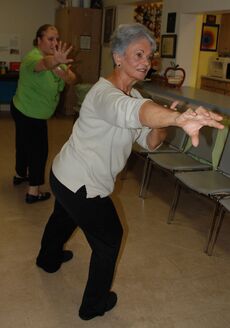Fear of Falling
Introduction[edit | edit source]
Fear of falling (FOF) describes a phobic reaction to standing or walking (called “ptophobia”) and also includes reductions in balance self-efficacy, nervous anticipation of falling, and/or a harmful avoidance of activity resulting from FOF. Falls self-efficacy can be defined as 'a person's belief in their ability to undertake certain activities of daily living without falling or losing balance.
- Prevalence rates among older persons for FOF range from 20 to 39% overall and from 40 to 73% in those who have fallen.
- FOF for older persons leads to loss of confidence, deconditioning from activity restriction, increased risk for subsequent falls, increased frailty, diminished social activity, risk of nursing home admission, and lower quality of life (QOL).[1][2]
- Roughly one-third of elderly people develop a fear of falling after a fall and this issue should be addressed in a physical therapy rehabilitation programme. [3] Please see the Falls page for further detail.
Who Is At Risk Of FOF[edit | edit source]
Reasons older people can may have a FOF include:
- Previous fall
- Feeling unsteady
- Diminished health
- Believing they are unable to do normal activities (low falls self-efficacy)
- Reduced ability to perform ADLs
- Frailty
- Poor vision
- No close family or friends for emotional support
- Sedentary lifestyle[2]
Clinical Presentation[edit | edit source]
FOF shows a clinical presentation with these features:
- Functional Decline: The person may have had a fall or known someone who had a fall and sustained serious injuries. As a result, the person becomes fearful of moving in case they fall and hurt themselves. As a result, they will reduce their usual activities which can show up in a subjective of the person's recent activities or ADLs compared to what they[4], or a carer, report they used to do. A longer exposure to FOF has been linked with an increased risk of functional decline[5].
- Reduced Mobility: The result of reduced ADLs leads to muscle weakness and loss of balance reactions which increases the person's actual chance of falling. Hence a FOF can become a "self-fulfilling prophecy" and a cycle of fear, reduced activity, reduced physical function, falls and injuries and so on.
- Anxiety and Depression: In regards to anxiety, Harding et al distinguish between anxiety accompanying the activity e.g. nervous whilst walking outside down a steep path, versus anxiety which prevents activity e.g. "I am anxious at the thought of going outside and falling in the garden and breaking a bone so I am not going to do gardening anymore." The individual may present with depression and low mood and not being able to participate in their usual ADLs and social roles as a result of their FOF.[3]
Diagnostic Procedures[edit | edit source]
Subjective Assessment[edit | edit source]
Should include:
- Recent pattern of activity - over days, months, year
- History of falls including incident, any subsequent treatment and rehabilitation, life changes (or not) after fall/s
- Current living situation
- Current mobility both in the home and in the community
- Descriptions of activities that cause the person anxiety
- Medications the person in currently taking
- Previous treatment for anxiety in general and if/how FOF has been treated in the past
Objective Assessment[edit | edit source]
Should include:
- Mobility in functional tasks e.g. transfers on/off chair and bed, walking indoors, walking outdoors, mobilising on steps, mobilising to and from bathroom, what aids (if any) are used or have been tried in the past
- Balance
- Strength of trunk and limbs
- Level of anxiety
- Cognition - although this may fall outside of the physiotherapist's scope of practice
Outcome Measures[edit | edit source]
Current FOF measures range include:
- Asking a single question about FOF (e.g., “Do you have a fear of falling?”)
- Scales examining FOF during specific activities (e.g. Fear of Falling Avoidance Behaviour Questionnaire)
- Scales examining perceived self-efficacy in one’s balance and/or ability to avoid falls (e.g. Falls Efficacy Scale International (FES-I)).
A 2021 Scoping Review on FOF found that " FES is likely more sensitive for detecting FOF than single questions, though further studies comparing the predictive validity of single questions to the FES and other FOF measurements are required"[1].
Management / Interventions[edit | edit source]
Management includes:
- Addressing underlying modifiable risk factors e.g. reduce medications with input from doctor
- Use exercise to focus on balance training to prevent falls
- Increase self-efficacy in mobilising.
Physiotherapy[edit | edit source]
A recent, Cochrane study[6] of community-dwelling adults over 65 has shown that exercise reduces the rate of falls and the number of people experiencing falls in older people living in the community. What works (based on a 2007 systematic review):
- A home-based multifactorial falls prevention program eg Otago balance program
- Home-based exercise
- A community-based Tai Chi group[2].
The following are techniques that should all be incorporated in therapy.
- Muscle Strengthening: Elderly adults are at risk of reduced muscle bulk and function but this can be reversed to a degree so a progressive strengthening programme should be initiated.
- Balance Training: This can begin with the tasks or activities the individual finds stressful or anxiety-inducing. If this is too difficult, then the activity can be broken down into smaller parts first then progressed from there. Tai Chi and the Otago Exercise Programme are proven interventions for improving balance which then ideally will produce increased confidence in mobilising.
- Build Self-efficacy: Building self-efficacy can involve psychological techniques e.g. cognitive behavioural therapy, practising the tasks or activities that cause anxiety, working with the person to find strategies, teaching the person to reflect on their abilities and successes, increasing physical performance e.g. muscle strengthening, balance training. Goal setting may help guide treatment and help engage the anxious person in treatment by providing a meaningful outcome to work towards.
- Involve and Carers and Significant Others: As the elderly often have support whether they live in the community or in care facilities, it is valuable to engage their carers or family to carry out exercises, home modifications and supervise the older adult in challenging mobility situations.
Resources[edit | edit source]
See Physiopedia's Falls category.
References[edit | edit source]
- ↑ 1.0 1.1 MacKay S, Ebert P, Harbidge C, Hogan DB. Fear of falling in older adults: a scoping review of recent literature. Canadian geriatrics journal. 2021 Dec;24(4):379. Available:https://www.ncbi.nlm.nih.gov/pmc/articles/PMC8629501/ (accessed 10.11.2022)
- ↑ 2.0 2.1 2.2 Health Qld Gov. Stay on your feet. Available:https://www.health.qld.gov.au/stayonyourfeet/for-professionals/fear-falling (accessed 11.11.2022)
- ↑ 3.0 3.1 Vellas BJ, Wayne SJ, Romero LJ, Baumgartner RN, Garry PJ. Fear of falling and restriction of mobility in elderly fallers. Age Ageing. 1997 May. 26;3:189-93. Accessed 11.11.2022.
- ↑ Nagai K, Ikutomo H, Tagomori K, Miura N, Tsuboyama T, Masuhara K. Fear of falling restricts activities of daily living after total hip arthroplasty: A one-year longitudinal study. Clinical gerontologist. 2018 Aug 8;41(4):308-14.
- ↑ Choi K, Jeon G, Cho S. Prospective Study on the Impact of Fear of Falling on Functional Decline among Community Dwelling Elderly Women. Int J Environ Res Public Health. 2017. 14;5: 469. Accessed 25 September 2019.
- ↑ Sherrington C, Fairhall NJ, Wallbank GK, Tiedemann A, Michaleff ZA, Howard K, Clemson L, Hopewell S, Lamb SE. Exercise for preventing falls in older people living in the community. Cochrane Database of Systematic Reviews 2019, Issue 1. Art. No.: CD012424. DOI: 10.1002/14651858.CD012424.pub2. Accessed 26 September 2019.









